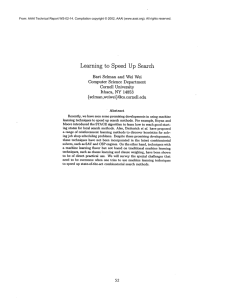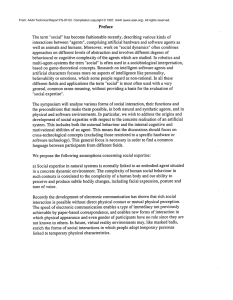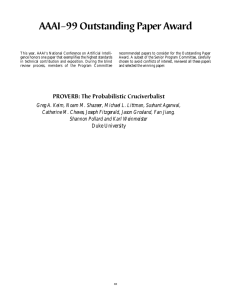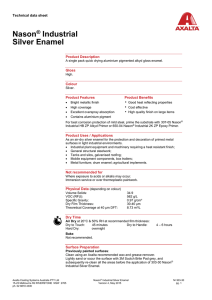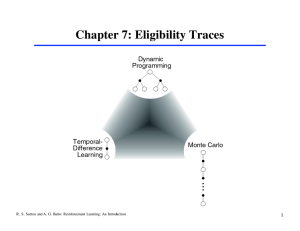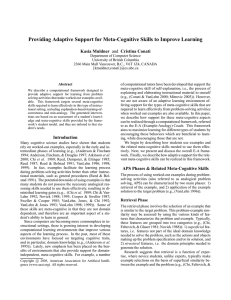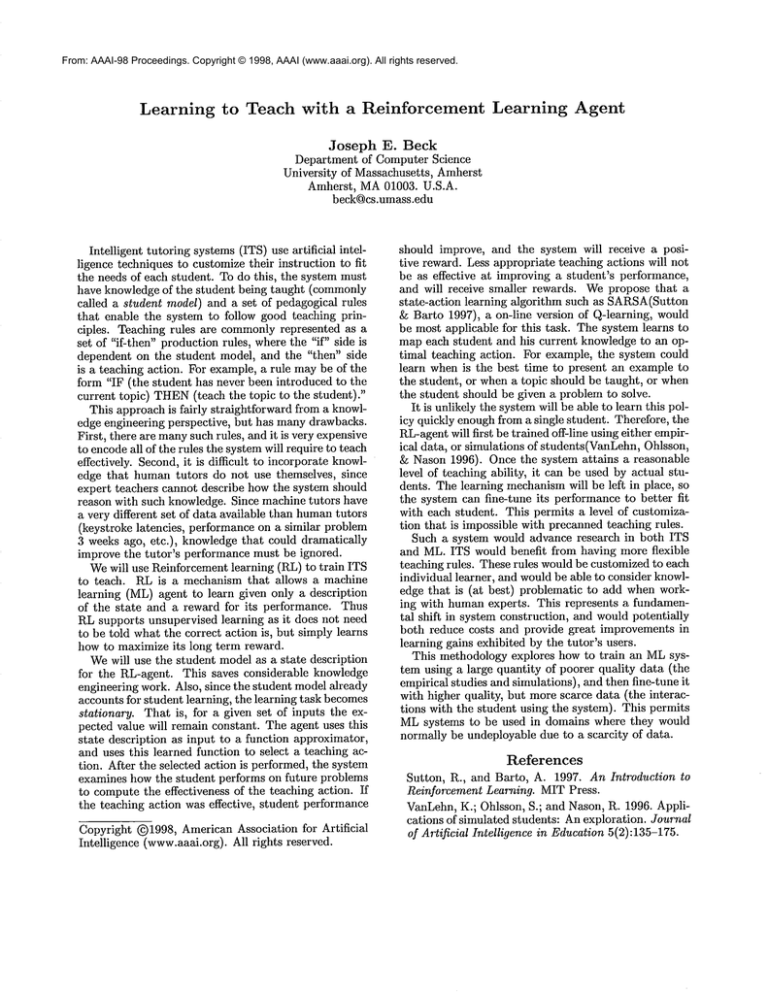
From: AAAI-98 Proceedings. Copyright © 1998, AAAI (www.aaai.org). All rights reserved.
Learning
to Teach with a Reinforcement
Learning
Agent
Joseph
E. Beck
Department of Computer Science
University of Massachusetts, Amherst
Amherst, MA01003. U.S.A.
beck@cs.umass.edu
Intelligent tutoring systems (ITS) use artificial intelligence techniques to customize their instruction to fit
the needs of each student. To do this, the system must
have knowledge of the student being taught (commonly
called a student model) and a set of pedagogical rules
that enable the system to follow good teaching principles. Teaching rules are commonlyrepresented as a
set of "if-then" production rules, wherethe "if" side is
dependent on the student model, and the "then" side
is a teaching action. For example, a rule maybe of the
form "IF (the student has never been introduced to the
current topic) THEN
(teach the topic to the student)."
This approach is fairly straightforward from a knowledge engineering perspective, but has manydrawbacks.
First, there are manysuch rules, and it is very expensive
to encodeall of the rules the systemwill require to teach
effectively. Second,it is difficult to incorporate knowledge that humantutors do not use themselves, since
expert teachers cannot describe howthe system should
reason with such knowledge. Since machine tutors have
a very different set of data available than humantutors
(keystroke latencies, performance on a similar problem
3 weeks ago, etc.), knowledgethat could dramatically
improve the tutor’s performance must be ignored.
Wewill use Reinforcementlearning (RL) to train ITS
to teach. RL is a mechanism that allows a machine
learning (ML) agent to learn given only a description
of the state and a reward for its performance. Thus
RLsupports unsupervised learning as it does not need
to be told what the correct action is, but simply learns
how to maximize its long term reward.
Wewill use the student model as a state description
for the RL-agent. This saves considerable knowledge
engineering work. Also, since the student modelalready
accounts for student learning, the learning task becomes
stationary. That is, for a given set of inputs the expected value will remain constant. The agent uses this
state description as input to a function approximator,
and uses this learned function to select a teaching action. After the selected action is performed, the system
examines how the student performs on future problems
to computethe effectiveness of the teaching action. If
the teaching action was effective, student performance
Copyright @1998,American Association for Artificial
Intelligence (www.aaai.org). All rights reserved.
should improve, and the system will receive a positive reward. Less appropriate teaching actions will not
be as effective at improving a student’s performance,
and will receive smaller rewards. Wepropose that a
state-action learning algorithm such as SARSA(Sutton
& Barto 1997), a on-line version of Q-learning, would
be most applicable for this task. The system learns to
mapeach student and his current knowledgeto an optimal teaching action. For example, the system could
learn when is the best time to present an example to
the student, or whena topic should be taught, or when
the student should be given a problem to solve.
It is unlikely the systemwill be able to learn this policy quickly enoughfrom a single student. Therefore, the
RL-agentwill first be trained off-line using either empirical data, or simulations of students(VanLehn,Ohlsson,
& Nason 1996). Once the system attains a reasonable
level of teaching ability, it can be used by actual students. The learning mechanismwill be left in place, so
the system can fine-tune its performance to better fit
with each student. This permits a level of customization that is impossible with precanned teaching rules.
Such a system would advance research in both ITS
and ML. ITS would benefit from having more flexible
teaching rules. These rules would be customized to each
individual learner, and wouldbe able to consider knowledge that is (at best) problematic to add when working with humanexperts. This represents a fundamental shift in system construction, and would potentially
both reduce costs and provide great improvements in
learning gains exhibited by the tutor’s users.
This methodology explores how to train an MLsystem using a large quantity of poorer quality data (the
empirical studies and simulations), and then fine-tune it
with higher quality, but more scarce data (the interactions with the student using the system). This permits
MLsystems to be used in domains where they would
normally be undeployable due to a scarcity of data.
References
Sutton, R., and Barto, A. 1997. An Introduction to
Reinforcement Learning. MITPress.
VanLehn,K.; Ohlsson, S.; and Nason, R. 1996. Applications of simulated students: Anexploration. Journal
of Artificial Intelligence in Education5(2):135-175.

